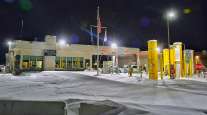U.S., Canada Agree to Coordinate Security at Border to Expedite Freight Shipments
This story appears in the Feb. 14 print edition of Transport Topics.
Trucking industry leaders in both Canada and the United States applauded an agreement between the two nations to spend the next two years streamlining and coordinating the plethora of agencies and regulations that govern security and freight movement at their border.
Under the agreement announced Feb. 4 at a White House meeting of President Obama and Canadian Prime Minister Stephen Harper, a new joint border council will review everything from incompatible electronic transponders to paper cargo manifests that can slow trucks and trade.
“This agreement is a positive first step to increasing the competitiveness of businesses on both sides of the border,” said American Trucking Associations President Bill Graves.
Trucks carry about 60% of the value of trade between the United States and Canada, its single largest trading partner, Graves said in a Feb. 8 statement.
A truck crosses the border at least once every three seconds, a border that has thickened considerably over the past decade since the attacks of 9/11, said David Bradley, president of the Canadian Trucking Alliance.
“We have been calling upon the governments on both sides of the border to enter into a new shared, smart border agreement for some time,” Bradley said in a Feb. 4 statement hailing the new agreement.
Bradley said he hopes it will “lead to a better balance between security and trade imperatives.” Without an efficient supply chain, Bradley said, the two nations cannot compete with emerging trading blocs around the globe.
The new United States-Canadian Regulatory Cooperation Council is to be composed of agencies from both countries that deal with security, trade, traffic and infrastructure at the border.
The new border council is to complete an action plan for enhanced border cooperation and compatibility within two years and to hold its first meeting within 90 days of the Obama-Harper meeting.
“The RCC has a two-year mandate to work together to promote economic growth, job creation, and benefits to our consumers and businesses through increased regulatory transparency and coordination,” the White House said in announcing the agreement.
On the same day Obama and Harper met at the White House, ATA representatives met with U.S. Customs and Border Protection officials to discuss truck issues at both the Canadian and Mexican borders. Graves called the meeting “a very open and positive discussion” about finding “ways to improve and expedite the movement of freight.”
Security and permit requirements for carriers hauling cargo back and forth across the Canadian border were a discussed at the U.S. Customs meeting.
Likewise, trucking on both sides of the border wants the new RCC to address those requirements, said Jennifer Fox, CTA’s vice president for customs issues.
“How can we work within regulation to reduce the red tape burden?”, Fox said. “There’s the regulatory side of it, there’s the technology side of it . . . and then there’s the system side of it.”
Many trucks crossing into Canada, for example, even Canadian trucks, have transponders that show they possess certain fast-track security permits, Fox said. But Canada does not have the technology to read the transponders, so trucks must stop to enter Canada. Going south, they do not have to stop to identify themselves because U.S. technology can read the transponders, she said.
Truckers from both countries would also like to see better use of electronic data entry systems so that they can declare cargo online days ahead of the crossing or perhaps afterward, Fox said.
Ideally, Fox said, the new RCC should, with input from the trucking industry, develop a single border crossing system so carriers do not have to deal with multiple sets of border regulations.



